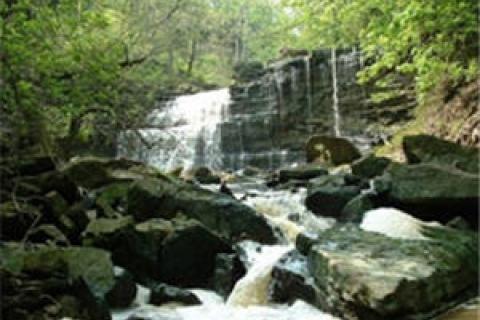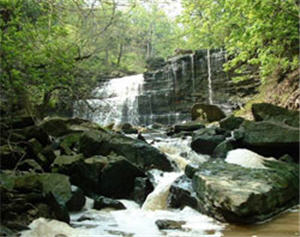
Hiking is a great way to spend time with loved ones or find solitude while giving your body a heart-pumping cardiovascular workout.
Every year, there comes a point when the first wave of warm weather melts the long deep winter freeze, revealing signs that spring is just around the corner. It's this time of year that the urge comes to get up and head out to your local woods or nature area and walk around. The only way to get rid of this subconscious demand is to go out for a day hike.
Why not? What better way is there to spend a free afternoon than to lace up your boots and forget about the hustle and bustle of everyday life in the fresh air? One important thing that many people don't realize is how useful a day hike can be. While it may be a great way to relax and get much needed exercise, it can also be a learning process. Every time you go for a take a step toward making yourself more confident in the outdoors.
 |
| Paths near meadows and river bottoms offer hikers the best chance at spotting wildlife. |
The single best thing about going for a hike is the fact that you can make the hike whatever you want. Long, short, strenuous or just a light workout, it's really up to the individual and the way they're feeling that day. Some people follow a very specific laid out path when they hike in hope of seeing special landmarks, landscapes or wildlife. Others seem to wander through the woods without a thought or purpose while taking in everything they see and hear. At the end of the day, whichever path you choose, the outcome will be the same: fulfillment.
Before going out for a hike, take a few seconds to sit and think about what exactly you hope to accomplish by going into the woods. Of course, there is always exercise, fresh air, or giving yourself space to think. But in most cases, people probably venture out into the woods simple because they are at heart true nature lovers hoping to see wildlife or that special up-close sunset.
Knowing what you want to get out of your hike helps you tailor your outdoor experience so you can get the most out of your few hours in the woods. For example, if you're going for a quick hike in search of wildlife, then you can take a path that avoids the deep woods and instead nears meadows or river bottoms, which give you a better chance to spot your quarry.
You can also bring materials to enhance your experience such as binoculars or a camera to record your experience. You'd be amazed at what you'll come across in the woods when you're quiet and persistent in your search. Deer, bear and eagles can become a staple in the visual context of most hikers if they pay attention to their respective hiking grounds.
With all that said, there is nothing wrong with simply getting out and going for a walk at the drop of a hat. Spontaneous hiking is great, and all you need for this is a place to hike and a little bit of ambition.
 |
| Some people follow specific paths when they hike in hopes of seeing special landmarks, landscapes or wildlife. |
Always make sure that someone knows where you went and what time you are suppose to be back -- even on day hikes. Accidents can happen anywhere or anytime. There is no better way to ruin your weekend then spraining or fracturing an ankle with no one around to help you get back to your car or campsite. Having an emergency plan can help get you out of those types of tricky situations.
A day hike can also be the perfect way to assess your body and your hiking gear. Some people don't exert themselves enough physically to know what parts of their body might not be in as good of shape as they thought. Equally as important, many hikers and backpackers don't allow a proper break-in period for new gear. By taking longer day hikes, you begin to learn which parts of your body tend to hurt first and why.
For example, if after 5 hours of hiking you feel your lower back beginning to ache, it might be time to consider better hiking boots or a new backpack. Even a light load between 5 to 10 pounds will make your back ache if you wear it incorrectly. Additionally, joints that take the majority of the pounding like your ankles and knees will always be tested on longer hikes, so starting out with short trails and working your way up to greater distances is a good way to learn how to hike efficiently.
Things to Bring
There are many different items you may want to have or bring on your hike. Some are more important than others, but keep in mind that the more you bring with you, the more weight you have to carry. Some of the basic necessities for experienced or beginner hikers are listed below.
- Comfortable walking shoes or hiking boots. Sandals are never a good idea. Additionally, if you happen to buy a new pair of boots, break them in before you hike in them. Blisters hurt.
- Water bottles or a canteen. You can bring a filtration water bottle as an alternative. If you do, you'll have to find a water source on the trail.
- Sunscreen.
- Insect repellent. If you use a product containing DEET, please make sure you are not allergic to DEET before you go out into the woods. Having a bad reaction to DEET in a remote location can turn out to be a life threatening situation.
- Some form of snack that won't turn to mush in the heat. Trail mixes with nuts, raisins and chocolate are a good idea.
- Medications that you may need. Ibuprofen or Tylenol is always a good idea for sore muscles and small aches and joint pain.
- Camera and accessories.
- Identification guides for local plants and wildlife.
- Map and compass.
- Cell phone. You probably will not have any reception in or around the woods, but having a cell phone handy is always good in case of emergencies.
The possibilities are endless when you enter into the world of hiking. When you go, what you do is completely decided by the way you feel that day. Hiking is a great way to spend time with loved ones or to get a little peace and quiet while putting your body through a heart-pumping cardiovascular workout. Just remember, each step of a hike is a step in the right direction.
- 6273 views

